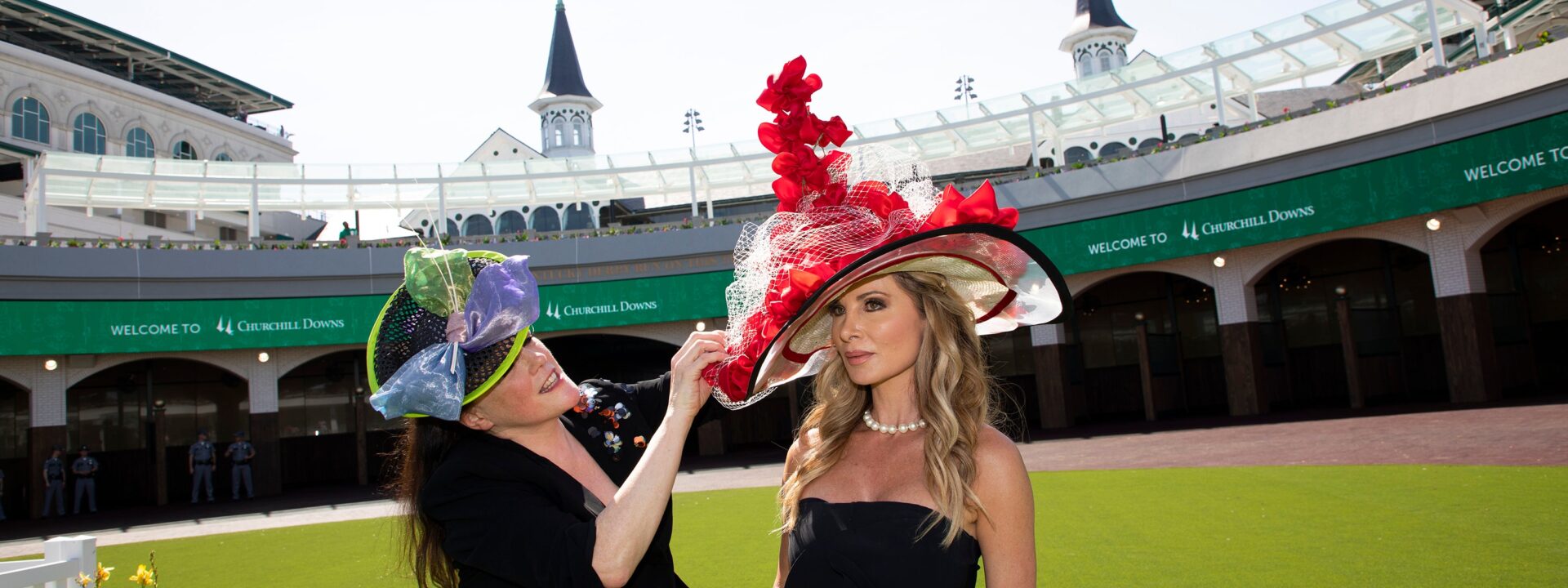While the Met Gala is still days away, another dazzling fashion event is unfolding thousands of miles away: The Kentucky Derby. Now in its 151st year, the Churchill Downs horse race celebrates jockeys, mint juleps, and some of the world’s most extravagant hats and fascinators.
The 2025 Kentucky Derby style guide encourages guests to embrace classic “race day occasion wear” with a modern twist, focusing on “the star of the show”—the Derby hat.
Walking through Churchill Downs, you’ll spot a sea of lavish hats, many designed by Christine A. Moore. A seasoned milliner with 20 years in horse racing, Moore crafts luxurious headpieces for the Derby and other prestigious races. Her background in costume design—including work on Broadway as an assistant to legendary milliner Rodney Gordon, creating hats for shows like Phantom of the Opera—infuses her designs with theatrical flair.
“Theatrical fashion is what I’m known for…and I think my attention to detail really sets me apart,” Moore told Vogue before last year’s 150th Derby. Speaking from her car between Churchill Downs and Louisville’s famed boutique, Rodes, where her hats are sold, she explained, “Everything is handmade in my style—we don’t buy pre-made flowers or bows. We start with raw fabric and materials, pressing and shaping everything by hand. That’s what makes us unique.”
One standout piece at this year’s Derby was Moore’s silk rosette hat, purchased by longtime Rodes client and Derby regular Patricia White.
For White, 2024 marked a return to the event after a four-year absence. She had originally planned a “head-to-toe yellow” outfit but changed course the moment she saw Moore’s black, white, and red rose creation.
“It completely transformed my look,” White said of the intricate hat. “As soon as I tried it on, I knew I had to wear it. The red roses felt like the perfect way to make a comeback after being away for so long.” (The Derby is often called the “Run for the Roses,” referencing the 544 roses awarded to the winning horse.)
Moore’s design paid tribute to her long history with the race, featuring 150 handcrafted silk roses in varying sizes—some with as few as two petals, others with 18. Made from silk taffeta, organza, horsehair, and wire, with a cotton lining, the hat also incorporated French netting woven between the blooms—everything “a Southern girl could want,” Moore said.
“[Moore] creates unique hats, but they’re always beautiful and feminine—even the edgier ones,” White noted. She paired the statement piece with a simple one-shoulder black dress to let the hat shine.
Explaining the design’s inspiration, Moore said, “Derby style is all about height and drama. I built the roses up on wire, starting with a focal 18-petal rose, surrounded by six-petal blooms, then tapering down to four and two petals.”
A sheer outer layer allowed light to illuminate the wearer’s face. “I love big hats,” Moore added, “but I always make sure they’re wearable.”
Video by Lili Kobielski”I think this one is too big,” said White. “But I like how the brim on this one is sheer.”
The hat took over 40 hours to make—30 hours to shape the individual petals and another 10 to assemble them. It was Moore’s most expensive piece this year, priced at $5,000. (Her hats typically average around $1,100.)
Along with White’s floral design, Moore—whose creations have even reached Britain’s Royal Ascot—also crafted the hat worn by Derby’s National Anthem performer and five-time Grammy winner Wynonna Judd.
Photographed by Lili Kobielski
“I specialize in swirled top hats, a technique I learned from Rodney Gordon,” Moore explained. “We made all the Phantom of the Opera top hats with that traditional swirl. Very few milliners can actually do it.” Judd wore one of Moore’s signature top hat designs.
The Derby is one of Moore’s busiest seasons. For the event, her studio uses about 700 yards of silk, crafting hats with 50 or more hand-sewn petals, like White’s. “Since starting my business in 1994, we’ve sewn over 30,000 labels into my hats,” she said. Moore also ensures no fabric goes to waste, creating pieces meant to be reworn and passed down.
“What I do is definitely not fast fashion,” Moore said. “With just one yard of fabric, I can do so much. Every scrap gets used—even tiny pieces become petals.”
“Some people insure my hats. They’re investment pieces, keepsakes meant to be handed down. Customers tell me they plan to save them for their children.”
While White admits to buying a new hat each year, she makes sure her past ones don’t sit unused. “I usually get a new one annually,” she said, “but someone might borrow an old one, or my mother will wear it. Sometimes I donate hats to auctions.”
Though extravagant hats are niche, White and Moore have noticed more people embracing them. “When I first started attending the Derby, I never wore hats,” White said. “Now, I wear simpler versions to horse shows or even dinners. You see them beyond the Derby.”
Despite the decline in hat-making, Moore remains dedicated. “People save up for my hats—I’d have to save for one myself,” she said. For those who value the craftsmanship, it’s a meaningful indulgence. “It brings so much joy. It’s wearable art.”
